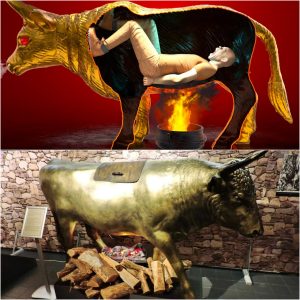During excavations at Anyang, a city in central China’s Henan province , archaeologists from the Anyang Institute of Cultural Relics and Archaeology discovered a centuries-old tomb that dates back to the era of the Sui Dynasty , which controlled the country from 581 AD to 618 AD. Since finding the site in April 2020, they’ve unearthed an impressive collection of earthenware and stoneware, including several porcelain figurines that feature elements of ultra-fine handiwork. Most recently, the Anyang Institute archaeologists announced two prize discoveries unearthed inside the tomb that may alter existing theories about ancient Chinese culture.

What Have They Found in the Sixth Century Tomb?
At a central location in the tomb, the researchers found a well-preserved white marble coffin bed. Intriguingly, it was carved with striking patterns and imagery that seem to merge Buddhist elements and motifs with those harvested from Zoroastrianism, the dominant religious tradition in Persia (modern-day Iran) at the time the tomb was built. It is known that Persian travelers were forming permanent communities in China from the sixth century on, and the characteristics of the carvings on the coffin bed suggest they were influencing Chinese cultural practices in some notable ways.
Besides the insights it can offer into Zoroastrian influence in ancient Chinese society , the coffin bed has other important information to reveal. According to Jiao Peng, the cultural relics and archaeology institute’s excavation department director, the marble bed will be an invaluable resource for experts studying the carving techniques that were in use during the Sui Dynasty era. Other archaeologists and historians will focus on studying the physical structure of the marble bed, to learn more about how coffins for elites were designed and built in ancient times.

In addition to the marble coffin bed, the other significant find was a fully legible epigraph, which offers a written history of the life of the two occupants of the tomb, who were identified as a couple that went by the name Qu Qing. The archaeologists note that the style of calligraphy used in the epigraph was very much unique to the sixth century, which will help calligraphy experts unlock further secrets about how Chinese calligraphy styles changed and evolved over time.
It isn’t clear yet what status the couple may have attained in their society. But the discovery of the elaborately carved marble coffin bed, the long and detailed epigraph, and some high-quality pottery and human-shaped figurines strongly implies they were seen as important people whose lives deserved to be honored and remembered. If it is ultimately determined that the Qu Qings were important personages, researchers may gain some significant insights into the hierarchical structure of Chinese society as it existed at that time. Continuing study of the tomb and its contents will reveal more about how Sui Dynasty-era society reacted to the loss of prestigious individuals, and about what steps they took to facilitate their ascension and ease their transition to more sublime realms.

Amongst the remains found in the Chinese tomb was a fully legible epigraph. The ancient epigraph offers a written history of the life of the two occupants of the tomb, a couple by the name Qu Qing. (Zhou HuiYing / China Daily )
Rediscovering the Sui Dynasty
While the Sui Dynasty reigned for only 37 years, the bold actions of its power-hungry emperors had a profound impact on the lives of its people. The Dynasty’s founder, Emperor Wen, took control of the northern half of a divided China in a coup against his own six-year-old grandson, who had been placed on the throne by his daft father shortly before the latter’s death. After ruthlessly murdering his son-in-law’s blood relatives to secure his hold on the throne, Wen set about to unify the country under his authoritarian rule. He eventually raised a 500,000-strong army, and met little resistance from the ruling dynasty in southern China when he marched his soldiers into their territory. In 589 the south surrendered, giving Wen and his Sui Dynasty control over the entire country.

The Sui Dynasty’s most lasting legacy was attained through internal developments. The Grand Canal that links the Yangtze and Yellow Rivers was constructed in its original form during the Sui Dynasty, using conscripted workers acting under the command of the mad Emperor Yang, Wen’s successor. Like so many megalomaniacs, Yang wanted to be remembered for eternity, and he launched his great landscape-altering project as a way to secure his place in history.
Ultimately, it was Yang’s ambition that led to the collapse of the Sui Dynasty empire, less than four decades after it was originally formed. Yang’s territorial ambitions knew no bounds, and while he was able to seize some land from the Vietnamese in the south through aggressive military campaigns, his attempts to duplicate that success in the north in Korean territory resulted in catastrophic defeat. His increasingly unpopular government was overthrown in 618, and a new (and largely now forgotten) dynasty soon sprung up to take its place.
A Merging of Cultures Along the Silk Road
“The Qu family lived in the Longxi area, which occupied the main part of the Silk Road for a long time, so they were deeply influenced by European, West Asian, and Central Asian cultures,” Kong Deming, the leader of the Anyang Institute of Cultural Relics and Archaeology, told China Daily .
For nearly two thousand years, the legendary Silk Road linked China to Europe and all points in between. Its primary purpose was to facilitate long-distance trade, but in addition to its economic impact it also helped shaped the social, cultural, and religious evolutions of the peoples and nations it connected.
In the trade between Persia (modern-day Iran) and China, silk, paper, rice wine, and drugs went from east to west while carpets, furniture, textiles, pearls, and a cornucopia of gourmet delights traveled in the other direction. Creating a far more enduring legacy, however, were the Zoroastrian traders and settlers who brought their worldviews and cultural and spiritual practices to the Chinese interior.
Starting in the seventh century, when the couple known as Qu Qing may have lived, Persians of the Zoroastrian religious persuasion began coming to China to stay. They built temples and created thriving communities that inevitably influenced the beliefs and activities of their largely Buddhist neighbors. Buddhism is a naturally syncretic religion, and consequently it could have been expected to incorporate certain concepts from Zoroastrianism once the latter religion had gained a foothold in the area.
Whatever titles the Qu Qings may have held, it seems they were sophisticated, cosmopolitan people who had no compunctions about adopting at least some Zoroastrian styles and traditions as their own. Their syncretic use of Buddhism and Zoroastrian imagery and pattern choices may ultimately reveal interesting and surprising details about Chinese society as a whole, if further archaeological discoveries show that syncretic practices were common in areas where Persian emigrants and Chinese indigenous residents mixed freely during ancient times.





